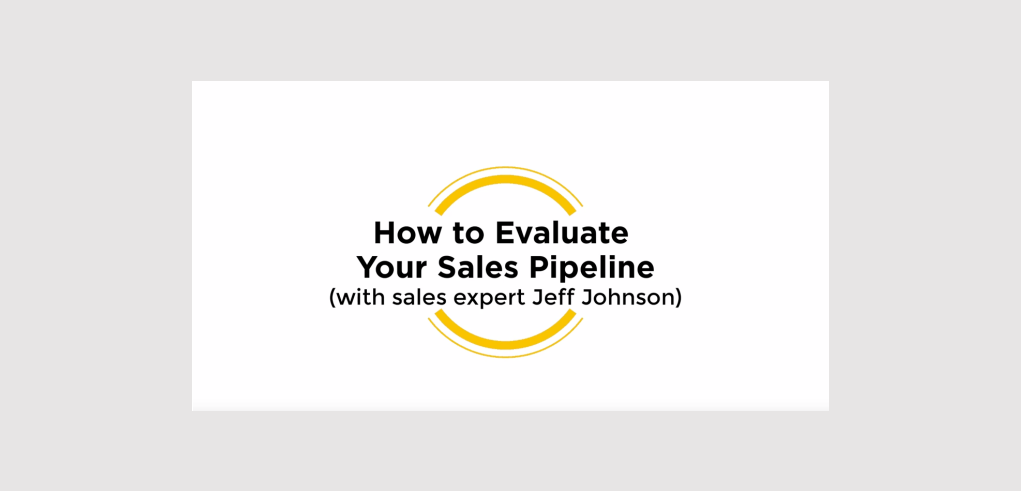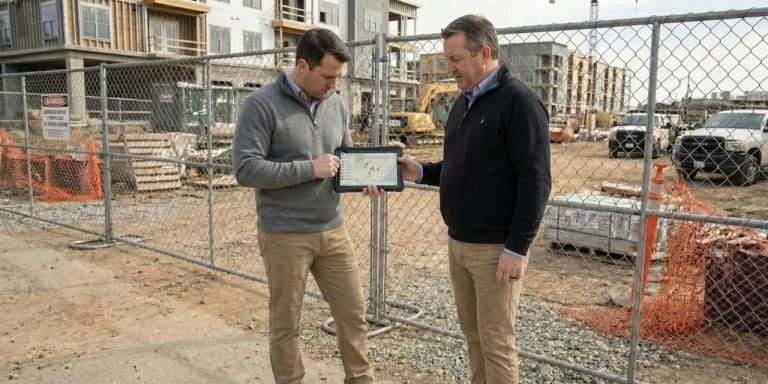Our interview with sales guru Jeff Johnson discusses how you should evaluate your sales pipeline. In this video, we discuss:
What must your pipeline contain in order to be most fruitful?
How often should you review and refresh your pipeline?
Is there a magic number you should always have in your pipeline?
How do you ensure success of your pipeline just across the board?
[beginning of recording]
Speaker: Okay, we are back with our sales guru, Jeff Johnson. Welcome.
Jeff: Well, thanks, I like to be referred to as a “guru.”
Speaker: You did it yourself.
Jeff: Okay.
Speaker: This is the second edition of our radio expert series. The last time, we discussed selecting your “A” players. Today we’re going to discuss how to evaluate your sales pipeline. So, enter Jeff, if you wouldn’t mind giving us a brief introduction, and we’ll get started.
Jeff: So, about myself. I’m a sales consultant. I work with small-to-medium sized companies, and we’re all about building sales teams to be more effective and really being the leaders in our space and enjoying what we do, and being very successful. So, that’s what our mission and goals are.
Speaker: Perfect. We will get started. Okay, first question. So, we’re going to talk about sales pipelines: how to keep them full, how to keep them fruitful, and keep everyone selling better. What must your pipeline contain in order to be most fruitful?
Jeff: Okay. That’s a very good question. I wish it was a simple answer; there’s a lot to it. So, I’m going to start with the foundation. When you start with the pipeline, you really need to have very well-defined milestones, and these milestones really should define the key things that the prospect must experience to be a qualified opportunity. And, typically, to give a quick review, initially, it’s pain and power, and it really depends upon how complex your sales cycle is, but the baseline is pain and power. Pain means that there’s some kind of powerful consequence that the prospect is experiencing that they want to get rid of, because every prospect loves to look at demos, hear sales pitches – sometimes, but it doesn’t mean that they’re always going to buy.
The foundation is: is there a consequence that they need to resolve? The second piece to that, if you have a larger, more sophisticated sale, you need to make sure you’re the decision maker. So, negotiating the power is always a very important piece of that. So, I would say your first milestone is pain and power. The second piece is it’s the investment. It’s not just the money. Depending on the solution that they’re buying, it’s really the investment in dollars and effort. Are they really willing to invest the effort that they need to invest to get the results that they’re looking for? So, that’s the second milestone, and the third one is assuming that all of that lines up, is what is the decision-making process from here to get to close, that we kind of have a go, no-go steps, a demo, a technical review, whatever that might be, and then we have an agreement that we’re going to go through that together, for the end purpose of making a purchase.
The final one is a verbal “yes” that you are the chosen vendor. Now, I think that there’s one piece to that that is very important, and that is this is all about what the prospect is experiencing and what the prospect is doing. It has nothing to do with how we feel about this sales cycle or any emotions.
The one thing that we want to keep out of a pipeline to make it fruitful is that we want to make sure that there’s no bloat, and that essentially means that we’re working on opportunities that have little or no merit that are going to drive these opportunities to closure, because if you have salespeople that are working on opportunities that you know early are not going to close, that salesperson is heading for disaster, essentially, and it’s our job, as leaders and managers, to guide them away from that. So, I call that “happy ears.” We want a sale, we have a quota, and Walmart calls and says, “Oh my gosh, we need X, Y, and Z,” and you’re hearing from somebody who’s got no power to buy, who really is just getting your information to negotiate with someone else. These are the kinds of things that you need to stay away from if you’re going to make sure you have a meaningful, fruitful pipeline.
Speaker: Great. So, you have your pipeline established, a good one, so you go about reviewing it. How often should you review, refresh, kind of checks and balances to your pipeline? Or, should it be perfect from the get-go, and in order to make the pipeline, you’re good?
Jeff: Wouldn’t that be nice? I’ve been doing this for 15+ years. As a consultant, I’ve never met a perfect pipeline. So, we can wipe that one off the board. Frequency, I think is, I’ll call it “situational.” So, situational is, you’ve got a new rookie, right, and to me, a pipeline review, I know that a new person is not going to be successful unless they can get new, qualified opportunities consistently into the pipeline with the right velocity. So, a new person, I’m going to have a pipeline review more frequently, and really focus in on qualifying new opportunities, and do they understand the underlying messages and processes to be able to do that, because I know, number one, if they can’t do that, they’re not going to be successful. So, that’s a type of pipeline review.
The second one is, I want to look at key deals. Obviously, there are some that are more complex and more important than others, and your pipeline review on those should really not be time-bound, it should really be stage-bound. So, when they reach a certain stage, before someone goes forward, let’s get the best thinking and strategy together on this and make sure we do the right thing upfront before we do it, versus let’s have a pipeline when we’ve done the wrong thing, and it’s gone sideways. That’s the most important thing to do.
And then, the third one is, yeah, you need to figure out – there’s an accountability piece to this. We should have a weekly, or biweekly, and it should be a normal course of review for everyone. So, I would say those three types of pipeline reviews would be the ones I would recommend.
Speaker: Great, okay. Any key metrics you focus on? Is it just MRR, ARR, or potential deal sites down the road?
Jeff: Very good. That’s a good question. So, when you’re looking at a pipeline, what I want to be able to do is I want to see the real value of the pipeline, and when we talk about milestones – and, everyone’s different, but it’s pretty close. I want to place probabilities at each milestone, and if I hit the milestone correctly, like the first one, normally a standard would be it’s a 25% probability to close. I’ve got pain, meaningful consequence, there’s a good reason to buy from someone who actually has the power to buy. One out of four times, those are going to close. Now, actually, we do a lot better than that, but it’s a pretty conservative view.
So, from a metrics perspective, what I always look at is the weighted value of the pipeline – not the full value, and this goes to forecasting. So, what I’m going to do is essentially take my opportunities, and multiply them by the probabilities, if I were to look at what’s going to happen this quarter, I would multiply that out, and that would give me my weighted pipeline for the quarter. If you’re doing it correctly, you should have a pretty darn accurate forecast. I think there’s one little free extra piece that I want to put in here, because there’s one little “getcha” in the pipeline, is the close date, and a lot of times, salespeople will put a close date in the pipeline, and that close date is their close date. It’s not the prospect’s close date, it’s their close date, because they’ve got a quota. It’s their close date, because they really want it to close then, and, oh, by the way, I’m going to get a bonus there, if I accomplish that. The close date should always be the prospect’s close date, and the prospect should tell us not only what the date is, but why that date is important. So, that’s another piece, just to make sure that your probabilities are correct and you’re not getting bloat in those kinds of things.
Speaker: Is there a magic number in the pipeline you should always have a threshold, how many potential opportunities? Or, is it in a flow?
Jeff: Another very good question. So, there’s kind of two pieces to that. Let’s say you have a million-dollar opportunity. Of course, we’d all love to have one of those, but let’s say you have a salesperson with one million-dollar opportunity that’s at the 25% stage. That’s a problem. Even though their quota may be $250,000, the probability would say you have $250,000 of weighted value in the pipeline; unfortunately, you don’t have a critical mass. The critical mass there would be four, because 25% means one-fourth is going to close. So, if I want to have an accurate pipeline that meets the probabilities, I need to have that critical mass that meets those probability requirements. Does that help?
Speaker: Yes, definitely.
Jeff: Great.
Speaker: For people just starting off building pipelines, for people who want to improve their pipelines, any just kind of parting words? How do you ensure success of your pipeline just across the board? I know it’s more complex than that.
Jeff: Yeah. So, here’s a recommendation. Actually, I’ve just started to blog a series on this, and it’s called – it’s a really good title: “Managing the Chaos in Your Sales Organization,” and it’s the pipeline series. The first one came out, so you can go to www.jeffjohnsonsales.com and go to my blog and look for it, and there’s no give, you can just download it. It lists out all of the milestones and definitions. That’s where you really need to start, because you can put things in the pipeline, but you have to know what it means. You really need to start with those milestones, understand what they are, and everybody needs to know – and not generally, everybody needs to know them by heart, because it’s very, very important. So, that’s where you start, and then when you do a pipeline review, the next thing is, you need to look at the key things. There’s nine of them, I think that comes out in the second episode, but off the top of my head, I would say if I’m doing a pipeline review, the things that I look at are: weighted value against the milestone’s stage, so I want to look at the pain; I also want to look at the next step, because a sales cycle is not a sales cycle unless there is a clear next step defined and agreed to between you and the prospect. So, the next step becomes very important. And, I also want to look at the age. So, given a milestone, there should be a sales cycle. If it’s real and moving forward, it’s consistent, and it’s going to be within a reasonable time frame. So, if something gets stale, you can immediately say either, “We need to get an agreement to go forward,” or, “We need to pull it out of the pipeline so we don’t get bloat.” So, the pipeline report, the milestones, those really are your foundational pieces to start with, is what I would recommend.
Speaker: Yeah, and we’ll be sure to link you guys so you can get the milestones and pipeline report and get your situation situated.
Jeff: There you go.
Speaker: Great. Well, any parting words, things you haven’t covered that you feel are important?
Jeff: Well, if I’m growing and managing a sales team, you just can’t do it without a good, solid pipeline. That’s foundational. I mean, I would call it a playbook. Here’s a truth that I see happening over and over: you give someone a goal, so, here’s your goal: go out and get 25 stage one opportunities, and here’s the definition. All of the sudden, your sales people on your team have a goal, and they’re probably going to start asking questions: “Where do I do this?” Well, that’s where sales process comes in. What’s your messaging? Who am I calling on? All of these things, and then you start building a process underneath it, but it always starts with this pipeline, which defines your sales process and milestones. So, that’s where you being, and without it, I don’t know how in the world you do it. So, if you don’t have one, get one, and it doesn’t matter if it’s www.salesforce.com, or Pipe Drive, that’s a good simple one. Remember that all it is is a container, that’s all that is, and we need to put the right information in to really understand the reality of what’s going on in the field, and it gives us the ability to be able to say, “Hey, this person needs some coaching, and I need to help him before it’s too late.” There’s many things that it does for you. So, I guess that would be my parting advice.
Speaker: Well, thank you very much for your time.
Jeff: It’s always a pleasure Jennette, thank you.
Speaker: I appreciate it, and we will be back next time with a new important topic. Alright, thanks Jeff. See you guys.
Jeff: Bye everyone.
[END OF RECORDED AUDIO]
______
Questions or comments? Contact SPOTIO at [email protected] or comment below.
SPOTIO is the #1 field sales enablement platform designed specifically for outside sales managers and reps to squeeze every drop out of their field sales efforts.
Want to see a product demonstration? Click here to see how SPOTIO can take your sales game to the next level.




